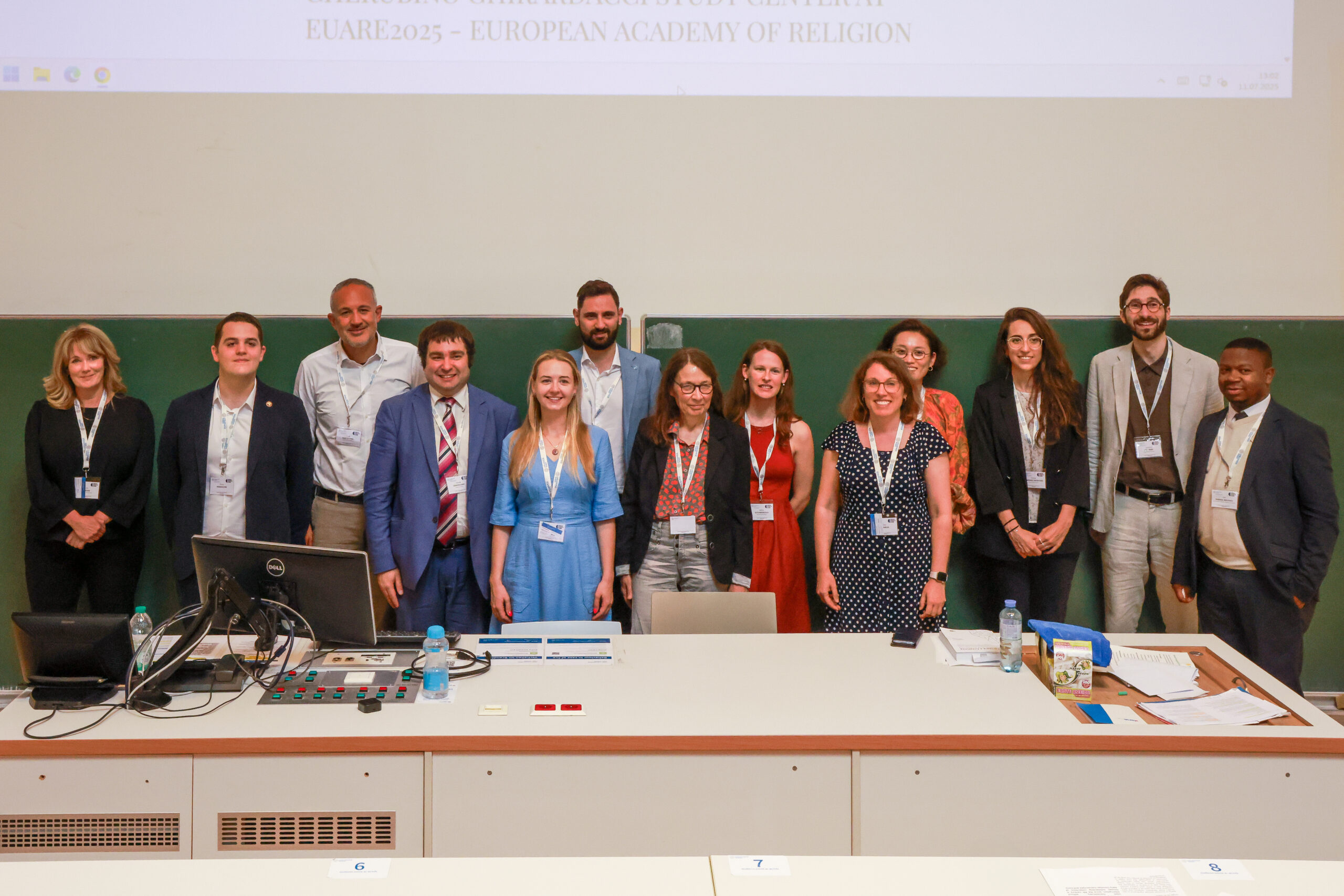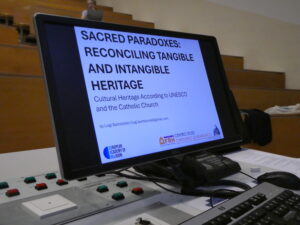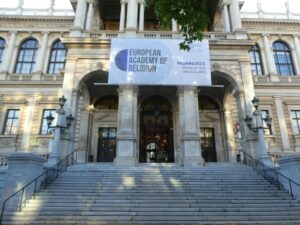
An overview of the Cherubino Ghirardacci Study Centre’s panel at the 2025 EuARe conference in Vienna
Sacred spaces and heritage communities, as well as tangible and intangible religious cultural goods: these are all fascinating and complex issues that require an interdisciplinary approach to be fully understood. For this reason, and thanks to the initiative of its president, Dr Luigi Bartolomei, the Cherubino Ghirardacci Study Centre – a non-profit association based in Bologna (Italy) and a member of FRH – organised an open panel to hold an in-depth discussion at the annual conference of EuARe, European Academy of Religion. This year, the event was hosted by the University of Vienna from 8 to 12 July. Thanks to the support of FRH, whose newsletter contributed enormously to spreading the call for abstracts to the panel, many authors sent in a proposal. After a careful evaluation of the submissions received, seven were selected, including those from three individual members of FRH: Dr Maria Arno, Dr Joël Baraka Akilimali and Dr Vanesa Menéndez Montero.
The panel, entitled Sacred spaces and community heritage: bridging the tangible and intangible, took place on 11 July 2025 and was co-chaired by Dr Gianluca Buoncuore, architect and president of AIGU, Italian Youth Association for UNESCO, and Dr Davide Dimodugno, a postdoctoral researcher in Law and Religion and an active member of the Young Researchers and Professionals Working Group of FRH. It gathered a multidisciplinary group of young researchers and professors, coming from universities located in a significant number of European countries (Belgium, Germany, Italy, the Netherlands, Poland, Spain and the United Kingdom). The topic was approached in an original fashion and from different perspectives, including architecture, law, history, theology and sociology.
The session was opened by Dr Luigi Bartolomei (University of Bologna) whose commitment to promoting international conferences on religious heritage is well known in the scientific community, as is his involvement in FRH activities, including an interview for the Heritage Handover Series. In his contribution on “Sacred paradoxes: reconciling tangible and intangible heritage”, he critically assessed the concept of “world heritage” in the 1972 UNESCO Convention and compared it with the contradictory configuration of tangible and intangible heritage advanced by the Catholic Church.

Dr Davide Dimodugno (University of Turin) followed with a presentation entitled “Safeguarding the intangible religious cultural heritage: from the 2003 UNESCO Convention towards a new understanding in Italian law and Canon law”, extending his previous research on buildings of worship. He delved into the complexities of intangible heritage with religious dimensions from a legal perspective, offering a multilevel analysis stemming from the 2003 UNESCO Convention, the Code of Canon Law and arriving at the future Italian Intangible Heritage Code, expected to be enacted by 2026.
After these introductory presentations, Dr Gianluca Buoncuore (University of Florence) faced the question from an architectural viewpoint. Speaking about “Life and forms of sacred spaces”, he provided some insights about the most recent developments in the construction of Catholic churches. He argued that round churches with lighting from the borders are the consequence of intangible cultural heritage: an adaptation to the action that takes place within the church.
Pietro Pandolfini, a student of BA in History at the University of Bologna, followed. He made his debut in academia with “The Bolognese “Campaneria” and its interaction with the material heritage: from the codification to today’s protection challenges”. Bell towers represent landmarks for local communities, and they can be considered res sacrae. Pietro drew attention to different kinds of sacredness and highlighted the risk of losing the “campaneria” as a living space and a lifestyle for the bell ringers.
Moving our gaze to Spain, Dr Vanesa Menéndez Montero presented the paper “Protecting beyond walls: safeguarding the intangible legacy of multipurpose religious heritage”. Building her considerations on her previous report for World Heritage Watch on the Mosque-Cathedral of Cordoba, the international legal scholar emphasised the importance of respecting and conciliating the spaces, narratives and discourses around mixed religious buildings –as envisaged by the CoE Faro Convention– and called for the consideration of such issues by the World Heritage Committee.
Dr Maria Arno (Warsaw University of Technology) spoke about “Adaptive reuse of sacred spaces: balancing tangible heritage and intangible cultural identity”. Taking Belgium and the Netherlands as case studies, she gave various examples of adaptive reuse of sacred spaces, addressing topics such as profanation and the tension between tangible and intangible values from the perspective of the conservators versus that of the Catholic Church. She argued that some social and cultural uses can be considered as “positive examples” of such adaptive reuse.
From the Catholic University of Louvain-la-Neuve in Belgium, Dr Joël Baraka Akilimali focused on “The Zairean rite beyond folklore: rethinking the architectural and artistic implications of ecclesiastical structures in postcolonial Africa”. This ritual, approved by the Congregation for Divine Worship in 1988, has had a profound influence on the sacred architecture of the Democratic Republic of Congo, representing a shining example of inculturation of the Catholic Church after the Second Vatican Council and a concrete way to bridge the tangible and intangible religious heritage in Africa.

With the paper “Encounters between sacred space and audio-visual cultures in British evangelical churches”, Dr Kate Jordan (University of Westminster) touched upon the link between churches and theatres in Pentecost movements. Many meeting places of these congregations are influenced by the architectural structures of auditoriums, implying a possible correlation and mutual influence in the way believers may understand participation in rituals as being equivalent to theatre or music performances.
A different perspective was suggested by Dr Sabina Rosenbergova and Dr Élise Roumeas (University of Groningen), who addressed the displacement of sacred objects from religious buildings to museums. Their contribution “Bridging the tangible and intangible in museums: the ethics of displaying religious objects” identified two possible strategies: the irenic narrative and the juxtaposition, both with different ethical implications. Through this research, these scholars sought to reinterpret museums as “spaces for pluralism”, with the aim of promoting better mutual understanding and peaceful coexistence in our multicultural societies.
The presentation “Rethinking sacred heritage between restoration and social practice: St Antony’s church in Forest Gate, East London” proposed by Dr Gimin Lee (University of Kent) and Dr Giacomo Damiani (Anglia Ruskin University) delved deeper into the participatory processes for the identification of new profane uses for Catholic churches in England. Their research focuses on a specific case study and is based on questionnaires distributed to the parish attendants and inhabitants of the multicultural neighbourhood, who have to identify and write down their historical, personal and community memories on the map of the building. In the long term, however, their aim is to go beyond and create a replicable methodology.
Finally, Dr Antje Roggenkamp (University of Münster) provided an in-depth theological explanation of altars, and an overview of the meanings related to the statues and paintings that ornament them. Through some examples in Germany, her speech on “Relics and the sacred in altarpieces – approaches to changing spatial environments” showed the different understandings of worshippers and other visitors to these sacred objects inside churches and museums, and the importance of “correct narration” to draw interest among an increasingly ignorant public in religious matters through new technologies.
Overall, this panel can be considered a first relevant momentum of mutual knowledge and understanding between people from different backgrounds, but united by a common passion and commitment to the protection and enhancement of religious heritage in Europe. This event should not remain isolated but rather serve as a basis for further collaborations on joint projects. The next opportunities to continue the dialogue and share new research are already foreseen for 2026, on the occasion of the next EuARe conference to be held in Rome (LUISS) from 30 June to 3 July, and other initiatives on religious heritage promoted and/or supported by the Cherubino Ghirardacci Study Centre.
Davide Dimodugno – University of Turin, Italy – Member of FRH
Vanesa Menéndez Montero – Independent Researcher, Spain and Germany – Member of FRH





Follow us: